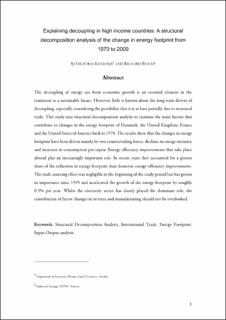| dc.contributor.author | Kulionis, Viktoras | |
| dc.contributor.author | Wood, Richard | |
| dc.date.accessioned | 2021-02-25T13:30:59Z | |
| dc.date.available | 2021-02-25T13:30:59Z | |
| dc.date.created | 2020-11-02T13:38:07Z | |
| dc.date.issued | 2020 | |
| dc.identifier.citation | Energy. 2020, 194 . | en_US |
| dc.identifier.issn | 0360-5442 | |
| dc.identifier.uri | https://hdl.handle.net/11250/2730460 | |
| dc.description.abstract | The decoupling of energy use from economic growth is an essential element in the transition to a sustainable future. However, little is known about the long-term drivers of decoupling, especially considering the possibility that it is at least partially due to increased trade. This study uses structural decomposition analysis to examine the main factors that contribute to changes in the energy footprint of Denmark, the United Kingdom, France and the United States of America back to 1970. The results show that the changes in energy footprint have been driven mainly by two countervailing forces: declines in energy intensity and increases in consumption per capita. Energy efficiency improvements that take place abroad play an increasingly important role. In recent years they accounted for a greater share of the reduction in energy footprint than domestic energy efficiency improvements. The trade sourcing effect was negligible in the beginning of the study period but has grown in importance since 1995 and accelerated the growth of the energy footprint by roughly 0.5% per year. Whilst the electricity sector has clearly played the dominant role, the contribution of factor changes in services and manufacturing should not be overlooked. | en_US |
| dc.language.iso | eng | en_US |
| dc.publisher | Elsevier | en_US |
| dc.rights | Attribution-NonCommercial-NoDerivatives 4.0 Internasjonal | * |
| dc.rights.uri | http://creativecommons.org/licenses/by-nc-nd/4.0/deed.no | * |
| dc.title | Explaining decoupling in high income countries: A structural decomposition analysis of the change in energy footprint from 1970 to 2009 | en_US |
| dc.type | Peer reviewed | en_US |
| dc.type | Journal article | en_US |
| dc.description.version | acceptedVersion | en_US |
| dc.source.pagenumber | 10 | en_US |
| dc.source.volume | 194 | en_US |
| dc.source.journal | Energy | en_US |
| dc.identifier.doi | 10.1016/j.energy.2020.116909 | |
| dc.identifier.cristin | 1844151 | |
| dc.description.localcode | © 2020. This is the authors’ accepted and refereed manuscript to the article. Locked until January 6th 2022 due to copyright restrictions. This manuscript version is made available under the CC-BY-NC-ND 4.0 license http://creativecommons.org/licenses/by-nc-nd/4.0/ | en_US |
| cristin.ispublished | true | |
| cristin.fulltext | postprint | |
| cristin.qualitycode | 2 | |

